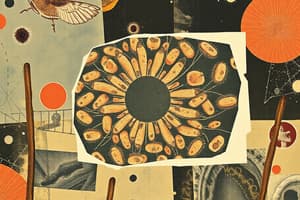Podcast
Questions and Answers
Who developed the first compound microscope?
Who developed the first compound microscope?
Hans & Zacharias Janssen
What did Robert Hooke discover?
What did Robert Hooke discover?
Pores/cells in cork
What term did Jan Evangelista Purkinje coin?
What term did Jan Evangelista Purkinje coin?
Protoplasm
What important statement did Theodor Schwann make?
What important statement did Theodor Schwann make?
What did Rudolf Virchow suggest about cells?
What did Rudolf Virchow suggest about cells?
Which of the following contributions was made by Anton van Leeuwenhoek?
Which of the following contributions was made by Anton van Leeuwenhoek?
The scientist who discovered that plants were made up of cells was __________.
The scientist who discovered that plants were made up of cells was __________.
Anton van Leeuwenhoek was the first to observe small, hollow compartments in cork.
Anton van Leeuwenhoek was the first to observe small, hollow compartments in cork.
Match the scientist with their contribution:
Match the scientist with their contribution:
Flashcards are hidden until you start studying
Study Notes
Year of Discovery & Key Contributors
- Hans & Zacharias Janssen (1595): Developed the first compound microscope using two convex lenses in a tube.
- Robert Hooke (1665): Discovered small compartments in cork, naming them "cells."
- Anton van Leeuwenhoek (1676): Observed tiny living organisms in pond water, discovered single-celled organisms termed "animalcules."
- Anton van Leeuwenhoek (1683): Identified bacteria from saliva samples.
- Theodor Schwann (1836): Proposed that all animal tissues are composed of cells.
- Matthias Schleiden (1838): Stated that all plant tissues are made of cells.
- Jan Evangelista Purkinje (1840): Coined the term "protoplasm" for cellular content.
- Rudolf Virchow (1855): Suggested that all cells arise from pre-existing cells.
Prokaryotic & Eukaryotic Cells: Similarities and Differences
- Prokaryotic cells are generally smaller and simpler than eukaryotic cells.
- Both cell types contain ribosomes, DNA, and a plasma membrane.
- Prokaryotic cells lack a nucleus; their DNA is located in the nucleoid region.
- Eukaryotic cells contain a defined nucleus where genetic material is enclosed.
- Prokaryotic cells reproduce asexually through binary fission; eukaryotic cells may reproduce sexually or asexually.
Animal Cell vs. Plant Cell: A Comparison
- Animal cells lack a rigid cell wall, while plant cells have a strong cellulose cell wall providing structure.
- Plant cells contain chloroplasts for photosynthesis; animal cells do not.
- Vacuoles in plant cells are large and central, whereas animal cells have smaller, temporary vacuoles.
- Animal cells typically have a more irregular shape; plant cells have a fixed, rectangular shape due to their cell wall.
- Both cell types contain mitochondria for energy production, but inplant cells, mitochondria are supplemented by chloroplasts for energy conversion from sunlight.
Studying That Suits You
Use AI to generate personalized quizzes and flashcards to suit your learning preferences.




